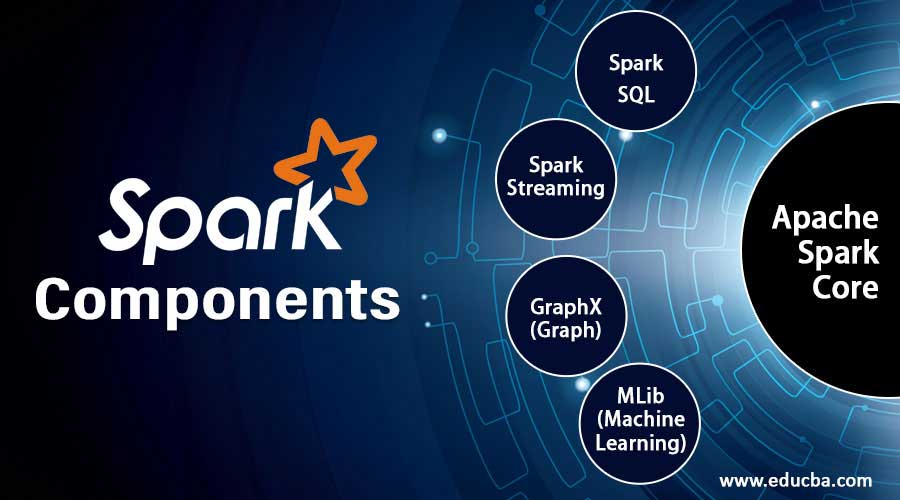
Overview of Spark Components
Spark Components are the features that are provided by the Spark framework for big data processing with a faster approach. Spark is known for processing large amounts of data for analytics solutions. There are 6 components associated with Spark ecosystems: Spark Core, Spark SQL, Spark Streaming, Spark MLlib, Spark GraphX, and SparkR. The big data processing industry widely uses Spark as a technology. It is a reliable and efficient technology in terms of performance. The Spark components work in-memory computation along with the disk or cluster-level storage feature that helps Sparks optimize the data processing.
Top Components of Spark
Currently, we have 6 components in Spark Ecosystem: Spark Core, Spark SQL, Spark Streaming, Spark MLlib, Spark GraphX, and SparkR. Let’s see what each of these components do.
1. Spark Core
As the name suggests, Spark Core is the core unit of a Spark process. It handles task scheduling, fault recovery, memory management, input-output operations, etc. Think of it as something similar to a CPU to a computer. It supports programming languages like Java, Scala, Python, and R and provides APIs for respective languages using which you can build your ETL job or do analytics. All the other Spark components have their APIs built on Spark Core. Spark can handle any workload because of its parallel processing capabilities and in-memory computation.
Spark Core comes with a special kind of data structure called RDD (Resilient Distributed Dataset) which distributes the data across all the nodes within a cluster. RDDs work on a Lazy evaluation paradigm where the computation is memorized and only executed when necessary. This helps in optimizing the process by only computing the necessary objects.
2. Spark SQL
If you have worked with Databases, you understand the importance of SQL. Wouldn’t it be extremely overwhelming if the same SQL code works N times faster, even on a larger dataset? Spark SQL helps you manipulate data on Spark using SQL. It supports JDBC and ODBC connections that connect Java objects and existing databases, data warehouses, and business intelligence tools. Spark incorporates something called Dataframes, which are structured collections of data in the form of columns and rows.
Spark allows you to work on this data with SQL. Dataframes are equivalent to relational tables, and they can be constructed from any external databases, structured files, or existing RDDs. Dataframes have all the features of RDD, such as immutable, resilient, and in-memory, but with the extra feature of being structured and easy to work with. Dataframe API is also available in Scala, Python, R, and Java.
3. Spark Streaming
In data streaming, we process a continuous stream of real-time data as a technique. It requires a framework that offers low latency for analysis. Spark Streaming provides high throughput, fault-tolerant, and scalable API for real-time data processing. It is abstracted on the Discretized Stream (DStream), representing a data stream divided into small batches. DStream is built on RDD, making Spark Streaming work seamlessly with other spark components. Some of the most notable users of Spark.
Streaming is Netflix, Pinterest, and Uber. Apache Kafka can integrate with Spark Streaming, allowing for the decoupling and buffering of input streams. Spark Streaming algorithms process real-time streams using Kafka as the central hub.
4. Spark MLLib
Spark’s major attraction is scaling up the computation massively, and this feature is the most important requirement for any Machine Learning Project. Spark MLLib is Spark’s machine learning component, which contains Machine Learning algorithms such as classification, regression, clustering, and collaborative filtering. It also offers a place for feature extraction, dimensionality reduction, transformation, etc.
You can also save and run your models on larger datasets without worrying about sizing issues. It also contains utilities for linear algebra, statistics, and data handling. Because of Spark’s in-memory processing, fault tolerance, scalability, and ease of programming, with the help of this library, you can run iterative ML algorithms easily.
5. GraphX
Graph Analytics determines the relationships between objects in a graph, for example, the shortest distance between two points. This helps in route optimization. Spark GraphX API helps in graph and graph-parallel computation. It simplifies graph analytics and makes it faster and more reliable. One of the main and well-known applications of graph analytics is Google Maps.
It finds the distance between two locations and gives an optimal route suggestion. Another example can be Facebook friends’ suggestions. GraphX works with both graphs and computations. Spark offers a range of graph algorithms like page rank, connected components, label propagation, SVD++, strongly connected components, and triangle count.
6. SparkR
More than 10,000 packages are available for different purposes in R, making it the most widely used statistical language. It uses data frames API, which makes it convenient to work with and provides powerful visualizations for data scientists to analyze their data thoroughly. R does not support parallel processing and limits itself to the memory available in a single machine. This is where SparkR comes into the picture.
Spark developed a package known as SparkR, which solves the scalability issue of R. It is based on distributed data frames and also provides the same syntax as R. Spark’s distributed Processing engine and R’s unparalleled interactivity, packages; visualization combines to give Data Scientists what they want for their analyses.
Conclusion
Since Spark is a general-purpose framework, it finds itself in many applications. Spark is extensively used in most big data applications because of its performance and reliability. The developers update all these components of Spark with new features in every new release, making our lives easier.
Recommended Articles
This is a guide to Spark Components. Here we discuss the basic concept and top 6 components of spark with a detailed explanation. You may also look at the following articles to learn more –
